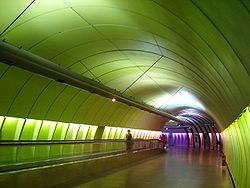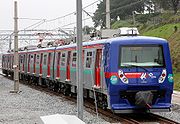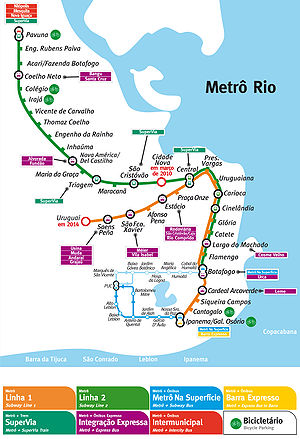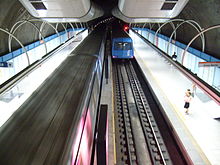- Rio de Janeiro Metro
-
Rio de Janeiro Metro 

Info Locale Rio de Janeiro Transit type Rapid transit Number of lines Lines 1 and 2 Number of stations 40 Daily ridership 580,000 (FY 2010) Operation Began operation March, 1979 Operator(s) Rio Trilhos Technical System map The Rio de Janeiro Metro (Portuguese: Metrô Rio, commonly called Metrô) is a mass-transit underground railway network that serves the city of Rio de Janeiro, Brazil. Founded in 1979 with five stations operating on one line, it now covers 47 km (29 mi) divided into two lines and 35 stations. It is the second largest metro system in Brazil after the São Paulo Metro.
The system currently consists of two lines, with another under construction:
- Line 1 (orange line), which serves downtown Rio, touristic areas in the South Zone, and several neighborhoods in the North Zone. It is a semi-circular line, and is fully underground. It runs from Saens Peña to Ipanema/General Osório.
- Line 2 (green line), which serves working-class residential neighbourhoods extending toward the north. It is a diagonal line, and almost completely over ground (mostly at graded and partly elevated). This line started as a light rail, but for increasing commuters, it gradually changed to metro. Due to its origin as light rail, it is at-grade except for Estácio station (the former connection station between lines 1 and 2), which is underground and Cidade Nova station, which is elevated.
- Line 4 (silver line), to be completed in 2016, will finally reach the Barra da Tijuca neighbourhood in the West Zone, passing under São Conrado and Rocinha. All stations will be underground, but there will be a bridge leading to a tunnel inside a mountain.
The Government of the State of Rio de Janeiro remains responsible for the expansion of metro network, through Rio Trilhos. In late December 2007, the lease was renewed until 2038 and Metro Rio assumed responsibility for the construction of Cidade Nova station, which will serve as a link between Line 2 to Line 1, ending the need to transfer Stations for the purchase of 114 cars and construction of Uruguai station, expanding Line 1 further north.
The extension works of Line 2, called Line 1A, which ended the transfer at Estácio Station and allow the direct connection from Pavuna to Botafogo were started by Metrô Rio on November 13, 2008 and the tracks were completed in December 2009. With the extension, the 250 thousand passengers that circulate daily on Line 2 don't need to change trains any more in order to get to the South Region. The interconnection of the two metro lines will reduce, by up to 13 minutes, the journey time from Pavuna Station to the city's Downtown, the destination of 83% of Line 2's passengers.
The Pavuna-Botafogo Direct Connection will be made available by means of the construction of a viaduct, with 1.3 km (0.8 mi) of extension, connecting São Cristóvão Station to Cidade Nova Station, which will be built on land located in front of Rio's Mayor's office, on the other side of Presidente Vargas Avenue.[1]
Contents
History
Rio de Janeiro is the second largest city of Brazil and the most important tourist attraction of the country. After 1950, the number of motor vehicles on the roads increased dramatically. Rio de Janeiro is situated in a hilly region, between the mountains and the Atlantic Ocean. The landscape of the city is extremely uneven, making traveling by car or bus a very time-consuming task through the narrow streets, which were ideal for tram but not for the increasing traffic of motor vehicles. By the early 1960s, traffic jams, pollution, and smog had become a serious problem in the city. To overcome these problems, local transport authorities decided to massively reduce the tram network and switch over to a metro network.
On December 14, 1968,[2] the Companhia do Metropolitano do Rio de Janeiro (Metro Company of Rio de Janeiro in English) was created by State Law number: 1736. In March 1975, with Law–Decree number: 25, the company effectively came into existence. On June 23, 1970, construction work started in Jardim da Glória. From 1971 to 1974, due to lack of resources, construction work stopped and was only resumed a year later. The Rio de Janeiro Metro began operating in March 1979, during the administration of governor Chagas Freitas. In the beginning, there were only five stations: Praça Onze (Eleven Square), Central, Presidente Vargas, Cinelândia, and Glória, operating from 9:00 AM to 3:00 PM.
In the first 10 days, the system transported more than half a million people, averaging sixty thousand passengers per day. At that time, the subway worked with only four trains of four cars each, with an average interval of eight minutes. In December of the same year, the operating schedule was extended until 11:00 PM, including Saturdays. In 1980, the metro system began to be expanded with the opening of Uruguaiana and Estácio stations. The two new stations caused larger passenger demand, compelling an increase in the number of trains from four to six.
The Carioca station in the Downtown Rio de Janeiro, the most active station with more than eighty thousand passengers a day, was finished in January 1981. By the end of the same year, the stations Catete, Morro Azul (now called Flamengo), and Botafogo were completed. In November 1981, Line 2 (or Linha 2 in Portuguese) started operating with only two stations: São Cristóvão and Maracanã (which serves the Maracanã football stadium). In December, completing the southern section of the first Line 1, Largo do Machado station began service. In 1982, the complementary inaugurations of the northern section of Line 1 started, with the beginning of operations of the Afonso Pena, São Francisco Xavier and Saens Peña stations.
To allow the completion of the second line to Irajá, in 1983, the trains on this line began operating from 6:00 AM to 2:00 PM. After a month, this schedule was extended until 8 PM, and a free bus service was established, integrating the Estácio, São Cristóvão, and Maracanã stations. After the conclusion of the works, the Pre-Metro and Maria da Graça, Del Castilho, Inhaúma and Irajá stations were opened. In 1984 the commercial operation of the second line began with five trains on work days with a five-and-a-half-minute interval during the week.
Following the expansion, the Triagem station was inaugurated in July 1988, the year of the creation of the subway/train integration ticket. In 1991, the Engenho da Rainha station was inaugurated. From 1991 to 1996, two stations were opened, Tomás Coelho and Vicente de Carvalho. In this period, the time interval of the nine stations of the second line was reduced to six minutes. In July 1998, Cardeal Arcoverde station, in the traditional neighborhood of Copacabana, was inaugurated. Five more stations became operational in the following two months: Irajá, Colégio, Coelho Neto, Engenheiro Rubens Paiva, Acari/Fazenda Botafogo and Pavuna.
In 1997, the Carnival Operation (Operação de Carnaval in Portuguese) began with continuous service during the Rio Carnival festivity days. In December of that year the system was privatised and the management and operation of the company passed into the hands of the Consortium Opportrans with a concession for 20 years, leaving the responsibility for expansion of the network in the hands of the state government of Rio de Janeiro through company Rio Trilhos. The Rio Reveillón is highlighted by the performance of Opportrans that since 1999 conducted a Special Operation to ensure a party for all. Tickets illustrated scheduled appointments to avoid overcrowding and provide the best service.
In 2003 Siqueira Campos station in Copacabana was inaugurated. Cantagalo station beyond Siqueira Campos was due to be completed in March 2006 but due to financial problems the opening date was postponed to December 15.[3] This was again postponed and the final opening took place in February 2007. At the same time construction began on the subway extension to General Osório station in Ipanema. This was opened in December 2009.
In late December 2007, Metro Rio renewed the concession for another 20 years to 2038, with the counterparts a number of improvements announced in early 2008 with a plan to expand the subway network and other improvements in the system: the project Metro Century.
Line 1A from Pavuna to Botafogo opened in December 2009 with a connection between São Cristóvão and Central. Passenger traffic at Estácio is reduced and the elimination of the need to transfer betweens lines 1 and 2 saves up to 13 minutes of journey time. A new station, Cidade Nova, was opened in November 2010 on Avenida Presidente Vargas on the new section[4]. The station is on Avenida Presidente Vargas and serves the City Hall.
The extension north from Saenz Peña from to Uruguai is expected to be completed in 2014
In June 2010, the construction of Line 4 began, linking Ipanema to Barra da Tijuca, where most of 2016 Olympic Games events will occur.
-
The President Luiz Inácio Lula da Silva and governor of Rio de Janeiro, Sérgio Cabral, at the now-open Cantagalo Station
Rolling stock
The passenger cars are of monoblock construction in stainless steel. Driving cars can accommodate a maximum of 351 passengers (40 seated), while non driving cars accommodate a maximum of 378 passengers (48 seated). Passenger train composition can vary between four and six cars. In six-passenger car configurations the maximum number of passengers that can be transported is 2,214.
Line 1 is served by exclusively old a type rolling stocks, which are full metro. Since Line 2 was formerly a light rail line, there are some old stocks which are converted light rail, i.e. light rails are converted to metro. New B type stocks are full metro stocks. This line is also served by old A type stocks.
Inside each coach, seat arrangement is both horizontal and vertical. When left side has horizontal (parallel to window) seats, right side has vertical (right-angle to window) seats, and vice versa. Each vertical seat has handle for easier standing, and backside facing. There are vertical rods from ceiling to floor for standing passengers, one set in front of horizontal seats, another set at middle of the coach. Both A and B type trains are air-conditioned.
Stations

- Line 1 (Orange): Saens Peña, São Francisco Xavier, Afonso Pena, Estácio, Praça Onze, Central, Presidente Vargas, Uruguaiana, Carioca, Cinelândia, Glória, Catete, Largo do Machado, Flamengo, Botafogo, Cardeal Arcoverde, Siqueira Campos, Cantagalo, General Osório.
 Satellite view of the direct conexion of Pavuna-Botafogo.
Satellite view of the direct conexion of Pavuna-Botafogo.
 Ticket kiosk of Rio Metro.
Ticket kiosk of Rio Metro.
All stations are underground. Cinelândia & Central stations have island platforms. Carioca, Saens Peña, Botafogo and General Osório stations has both side and island platforms, although Saens Peña consists of two island platforms and three tracks. The northernmost of the three tracks appears to be disused and planned for use after the Line 1 extension. Saens Peña is a very busy station, with train turnarounds made very quickly. All other stations have side platforms, up and down tracks are divided by a low wall at stations with side platforms. Siqueira Campos, Carioca, Central, Uruguaiana & Cardeal Arcoverde have a large mezzanine floor between surface and underground tracks.
Central, which is a major interchange point between the Metro, local and longer-distance bus lines, and the Supervia suburban electric rail network, is the busiest station of the network. Cardeal Arcoverde is the most beautiful station; platform area has been dynamited out of the base of São João Mountain and maintains a cave-like structure. General Osório have some painting on the hallways to remember prehistoric attempts to communication.
- Line 2 (Green): Pavuna, Engenheiro Rubens Paiva, Acari, Coelho Neto, Colégio, Irajá, Vicente de Carvalho, Tomás Coelho, Engenho da Rainha, Inhaúma, Del Castilho, Maria da Graça, Triagem, Maracanã, São Cristóvão, Cidade Nova, Estácio (to be closed on working days).
- Line 1A: São Cristóvão, Cidade Nova, Central, Presidente Vargas, Uruguaiana, Carioca, Cinelândia, Glória, Catete, Largo do Machado, Flamengo, Botafogo.
The Line 1A is actually the extension of Line 2 until Botafogo station. The Line 2 is elevated from Irajá to Colégio. Many of them have island platforms, although Pavuna has both side and island platforms. Underground from Central to Botafogo.
For its origin as light rail, it is fully over ground (except Estácio station, which is underground). Most stations like Irajá and others, has an island platform, whereas some stations like Triagem has side platforms. Maracanã station is directly linked by an overbridge to one of world's largest football stadiums, Maracanã Stadium, crossing the road.
Connections
- Line 1 is fully underground with Cardeal Arcoverde being the deepest station. This station is under São João mountain. Non-free interchange with the Santa Teresa Tram is possible at Carioca and with the SuperVia trains at Central. Interchange to Line 2 is possible all stations between Botafogo and Central. There is no more interchange with Line 2 at Estácio. Interchange to Bus is possible at Cardeal Arcoverde, Botafogo, Largo do Machado, Estácio, São Francisco Xavier and Sáenz Peña.
- Line 2 is fully overground, except stations on Line 1A. It is elevated from Pavuna to Irajá and the rest is at grade, except Cidade Nova, which is elevated. Interchange with train is possible at Triagem, Pavuna, São Cristóvão and Central. Interchange to line 1 is possible at Line 1A stations. Bus interchange is possible at Nova América/Del Castilho, Coelho Neto and Pavuna.
Fare structure
- Single Journey (Unitário in Portuguese): This is the most popular option. When a commuter buys a ticket from the counter, they then can travel by metro from any station to any station of any line. Once the commuter leaves the station, they need another ticket for another trip. There is a flat Single Fare (Unitário) R$ 2.80 regardless of distance.
- Single Combined Journey (Duplo in Portuguese): This is the most popular for long-distance travel. This ticket is valid on all forms of transport: metro, suburban train, and bus. A commuter can buy a ticket from a metro ticket counter, train ticket counter or from bus conductor and then can travel by metro from any to any station of any line and can transfer to bus or train from any metro station. Train and bus fares are not flat, so this transfer ticket's price varies by distance in bus or train. This ticket is very useful because it costs less for combining metro, train and bus; separate metro, train and bus tickets cost higher. It is popular on those routes that once had tram service, now has bus service, and are not served by metro — and to avoid long queue at train stations. The cost of this ticket is R$ 2.50–4.00 (transfer metro/train/bus).
Tickets are purchased from a cashier in a booth; no automated ticket vending machines are in stations. There is an ongoing campaign to change the old tickets (paper magnetic strip) until December 30, 2009.
Modernization
 Metro station in Rio.
Metro station in Rio.
The investment of R$ 1.15 billion contemplates also the purchase of 19 additional compositions: there will be 114 new cars with a technology that allows the passengers to circulate inside the train. The first of the new compositions arrives in December 2010 and the others will start operating gradually until December 2011. All of them will ride in Line 2 and will have a dimensioned air conditioning system to bear the sun and heat's direct incidence, as most part of the line is in the surface. With the increase of 63% of the fleet, the concessionaire will also standardize the compositions of Lines 1 and 2: all 49 trains will have six cars.
The control, signalization, ventilation and energy systems will be also expanded and modernized. The energy supply for the metro's operation will be reinforced with two new proper sub-stations, at Uruguaiana and Largo do Machado Stations, and with the remodeling of São Cristóvão and Central sub-stations. On the other hand, the signalization will be automated in the two lines. Metrô Rio will enhance the ventilation at the stations and will modernize all equipment of the Control and Operations Center, from where the complete daily operation is monitored. These actions, combined with the extension of Line 2, Will allow Metrô Rio to transport more than 1.1 million passengers/day.[5]
Expansion
The construction of Pavuna-Botafogo Direct Connection is also part of an investment package of R$ 1.15 billion undertaken by Metrô Rio, as of the renew of the concession contract with the Government of the State of Rio de Janeiro in December 2007. Entitled 21st Century Metro, the project, which also includes the expansion of Line 1 and other enhancements, will allow to more than double the Rio's subway capacity, from 600 thousand passengers/day to more than 1.1 million passengers/day. The extension of Line 1 will start as of 2012, with the recovery works of 1 km (0.6 mi) of via from Tijuca's tail, which goes from Saens Peña square until the corner of Rua Conde the Bonfim with Rua Uruguai, where Uruguai Station will be built. It is forecast that the expansion of Line 1 is completed until 2014, the year of 2014 FIFA World Cup in Brazil.[6]
See also
- List of rapid transit systems
- List of Rio de Janeiro metro stations
- Rio de Janeiro Suburban Train
- Santa Teresa Tram in Rio
References
- ^ The Metro in the 21st Century
- ^ http://www2.transportes.gov.br/bit/ferro/metro-rj/inf-metrorj.htm
- ^ SRZD | Sidney Rezende
- ^ http://noticias.r7.com/rio-de-janeiro/noticias/metro-rio-inaugura-a-estacao-cidade-nova-20101101.html "Metrô Rio inaugura a estação Cidade Nova," R7 1-11-10
- ^ Modernization - Rio Metro
- ^ Expansion - Rio Metro
External links
- Official Website (English)
- NYCSubway's page on the Rio de Janeiro Metro (English)
- Cantagalo Station information (Portuguese)
- Rio Trilhos (Portuguese)
- Rio de Janeiro metro map (English)
 Urban public transport networks and systems in Brazil
Urban public transport networks and systems in BrazilMetropolitan area
commuter railJoão Pessoa • Maceió • Natal • Rio de Janeiro • Salvador • São Paulo
Rapid transit Belo Horizonte • Brasília • Fortaleza* • Porto Alegre • Recife • Rio de Janeiro • Salvador* • São Paulo • TeresinaLight rail Arapiraca Metro* • Brasília Light Rail* • Cariri Metro • Macaé Light Rail* • Maceió Light Rail* • Recife Light Rail*Monorail Manaus* • São Paulo*Trolleybuses Santos • São Paulo(*) Under ConstructionCategories:- Metrô Rio
Wikimedia Foundation. 2010.








